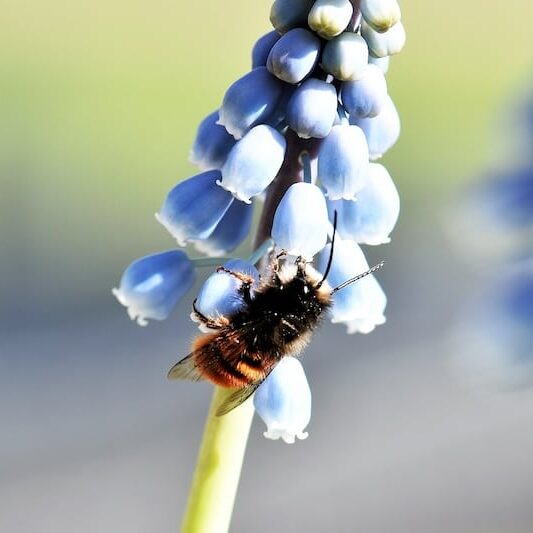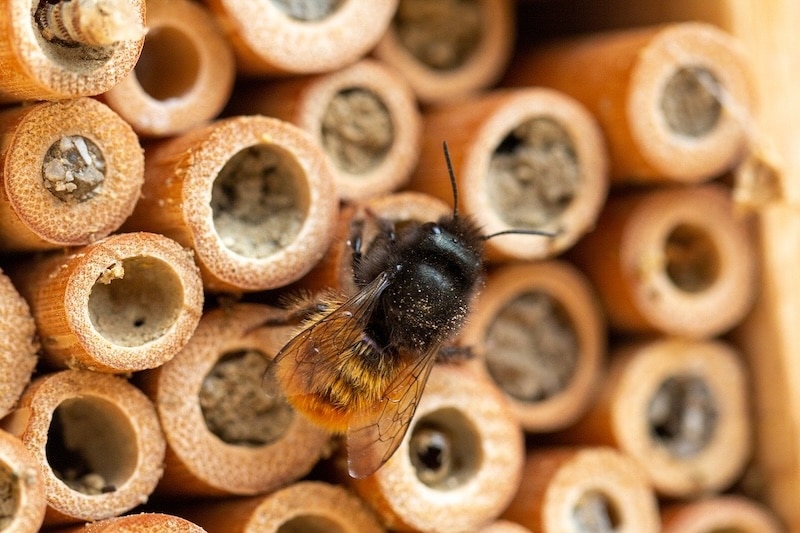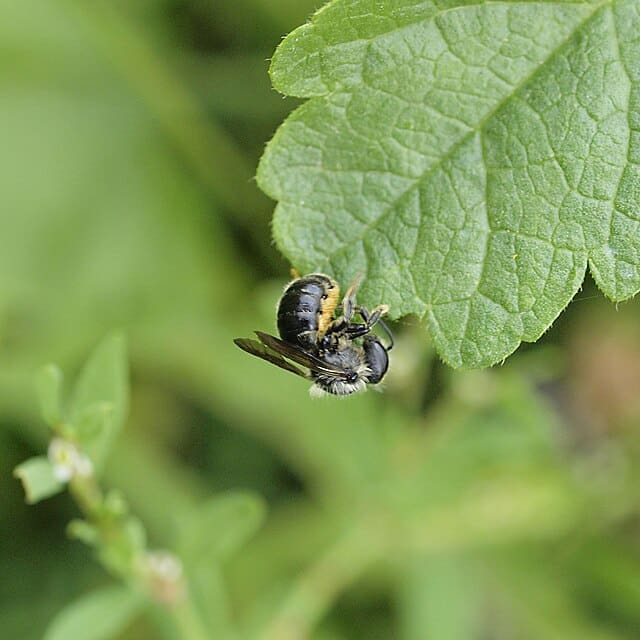Contents:
- What are Mason Bees?
- Mason Bee Anatomy and Morphology
- What does a Mason Bee Nest look like?
- What is the Lifecycle of a Mason Bee?
- Where are Mason Bees Native to?
- Types of Mason Bees and Species
- Mason Bee vs. Leafcutter Bee
- Mason Bee vs. Honey Bee
- What do Mason Bees pollinate?
- How to attract Mason Bees and create a Mason Bee Habitat
- Tips to Starting Your Own Mason Bee House
- 10 Fun facts about Mason Bees
- The Best Bees Company and Mason Bees
- FAQs
What are Mason Bees?
A Mason Bee is a term that is used to refer to any bee species in the genus Osmia, of the family Megachilidae. Mason bees (also known as masonry bees) are native bees, meaning that they occur naturally in a region, and they are aptly named for the materials they gather to make their nests.
Unlike the honey bee, Mason Bees are tunnel-nesting solitary pollinators, and they typically use mud or clay to seal the openings of their homes. According to the U.S. Forest Service, there are 140 species of Osmia in North America.
–– Interested in bringing Mason Bees to your property? Check out our Native Bee Hotel and Mason Bees Service Offering ––
Mason Bee Anatomy and Morphology
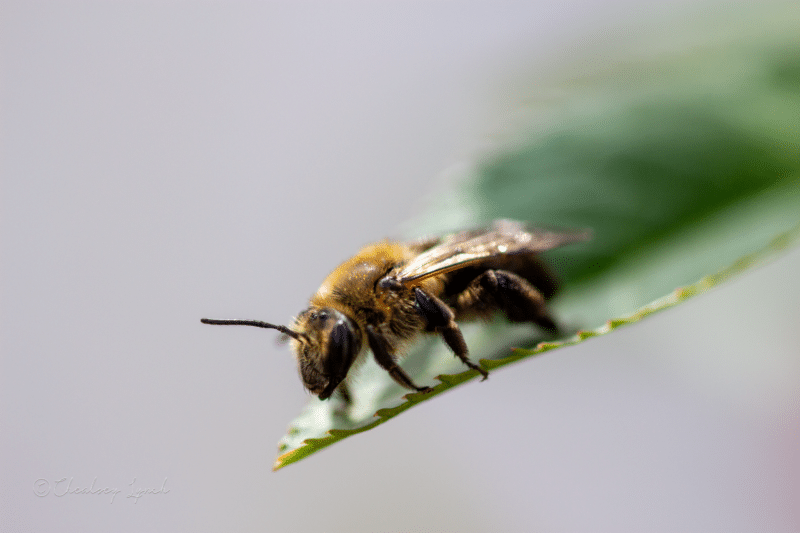
While there are many different species of the Mason Bee, these pollinators are smaller than a honey bee and tend to have distinct physical characteristics. The female is a black bee with an orange abdomen and feet, black fur on her face and thorax, and long red-brown hairs on the abdomen. The males are similar but have white fur on the face and a black abdomen with long orange hairs.
According to the Ecological Landscape Alliance, every female Mason Bee is a “queen” who lays eggs and raises offspring on her own, without the support of a highly-organized, social colony. The role of the male Mason Bee is much simpler than that of the female; they mate with the females and then die.
What does a Mason Bee Nest look like?
Mason Bees lay their eggs and nest inside existing tunnels, which can be created naturally by beetles and plants, or with the help of humans. The outside of a Mason Bee nest has various circles that are actually tunnels, and these tunnels are typically six inches deep. According to The Ecological Landscape Alliance, Mason Bees prefer holes that are 5/16” in diameter.
Inside these tunnels are where the Mason Bees will lay their eggs, with female eggs being deposited at the back of the tunnel away from predators, and male eggs being deposited in the front. Most importantly, the Mason Bee will seal the openings of their nesting tubs with mud at the end of the season, usually by early summer.
What is the Lifecycle of a Mason Bee?
The average lifespan of a Mason Bee is four to six weeks. This species prefers to nest in pre-existing cavities, with males emerging first. A newly mated female may build up to seven nests with a series of brood cells separated by mud partitions.
Female eggs are laid first and provided with larger stores of provisions of nectar and pollen. The eggs will then hatch a few days after they are laid in February/March but the larvae are not ready to pupate until August/September. Mason bees reach the adult stage but do not emerge–instead, they go into diapause (a period of suspended development in an insect) and spend the winter in their cells. After mating, the female bee leaves the nest site for a few days while her ovaries mature, but they often return to where they emerged and search for a nearby nesting cavity to lay eggs.
Where are Mason Bees Native to?

About 140 species of Mason Bee are native to North America, and they are commonly found in orchards, gardens, and allotments. NatureServe notes that an additional three species (Osmia cornifrons and O. taurus from Asia and O. caerulescens from Europe) have been introduced to North America. You will typically be able to find a Mason Bee throughout North America, aside from the far-north regions of Canada and Alaska.
Types of Mason Bees and Species
- Blue Orchard Mason Bee: According to the U.S. Forest Service, blue orchard bees have dark metallic blue bodies, and are not striped brown and orange like the honey bee. Once they emerge in early spring and mate, the blue orchard bee searches for empty holes that are the right size and shape for their nests.
- Red Mason Bee: This solitary bee is greenish-back to bronze. The head, thorax, and abdomen have pale brown hairs, and the top of the thorax has red or red-brown fur. The female Red Mason bBee has horns on her face, which she uses to smooth out soft mud onto the tunnel walls of their nests. These Mason Bees are active from March to June, nesting in soft mortar, soil, dead wood, gaps under roof tiles, or even existing burrows. One brood is raised each year, and the male bee emerges about two weeks before the female.
Mason Bee vs. Leafcutter Bee
While both the Mason Bee and Leafcutter Bee are solitary and docile pollinators that lay eggs in tube-like nests, there are a few key differences that set them apart. Kind Bee Farms makes the distinction between these two bees by examining the following:
- Sound: A Mason Bee can sound like a housefly with its buzzing nature, while a Leafcutter Bee is much quieter as it travels.
- Activity: Mason Bees typically emerge from their nests in spring to pollinate, while Leafcutter Bees come out of their cocoons in the warm, summer months of June-August.
Mason Bee vs. Honey Bee
Although the mason bee and honey bee are fantastic pollinators, they are far more different than you might think. Honey bees (Genus Apis) are truly social bees, and arguably occupy the top of the bee evolutionary tree. They form large perennial colonies consisting of a single queen, who may live for several years, male drones present for the summer season, and many sterile workers whose life span varies from a few weeks to many months. These large and complex colonies need large stores of food to survive through periods of shortage or cold weather. All species build combs made of wax secreted by the workers, taking the form of hexagonal cells arranged in one or more vertical combs.
Contrary to honey bees, mason bees do not produce honey and lack the venom that is found in the stinger of a honeybee, making them a great alternative to people who might be allergic to Honeybees.
Honey bees are an excellent indicator species, as they are commonly used in managed beehives across the United States. The Best Bees Company works with Apis mellifera ligustica, a docile breed of Italian honey bees, to track data about the health of honeybees nationwide, which can also help us understand the status of pollinators as a whole. To learn more about the latest data on honeybees and what scientists and beekeeping services are doing to protect them, download the 2021 State of the Honeybee Report.
What do Mason Bees pollinate?
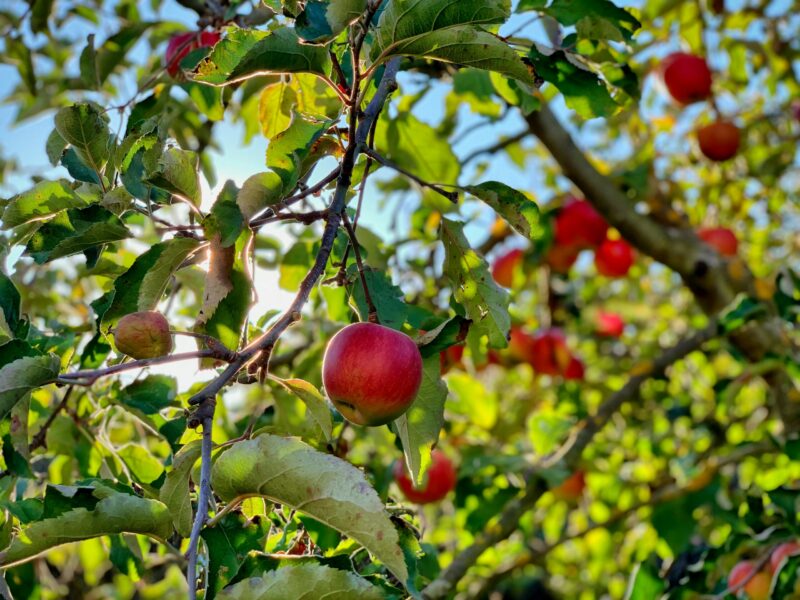
Mason Bees carry pollen in a specialized structure (scopa) on the belly rather than on hind legs or internally, limiting their ability to carry pollen efficiently back to the nest and thus requiring more frequent trips to flowers. Their behavior within the flower also covers them in pollen, which makes them particularly effective pollinators! Below is a list of plants and flowers that Mason Bees tend to pollinate:
- Currant (also known as gooseberry)
- Fruit trees such as apple, almond, plum, and pear
- Wild Cherry
- Elderberry
- Huckleberry
How to attract Mason Bees and create a Mason Bee Habitat
In addition to incorporating the plants and fruits above into your own garden, Mason Bees can be supported simply by creating a home for them. To create your own Mason Bee habitat, consider the following steps:
- Place hollow tubes 5/16” in diameter, either singly or clustered, between knee and shoulder height above the ground.
- Drilling holes about 6 inches (165 mm) deep in wooden blocks may also work, but ensure that the nesting holes are clean and straight with smooth entrances.
- Mount the habitat securely on the side of a building, tree or fence where it can have ample sunlight. Ideally, set out this habitat in mid-to-late March, before Mason Bee nesting begins.
- Allow the bees to move in by themselves.
Tips to Starting Your Own Mason Bee House
After a Mason Bee Habitat has been created, mounted, and bees begin to settle in, it’s important to understand how to care for these pollinators. First, avoid the use of pesticides on your property–all bees are sensitive to them and can become ill or even die if they are exposed to these harsh chemicals.
The Mason Bee is considered a more efficient pollinator than the Honeybee because of its pollen-gathering tactics, so be sure to provide enough pollen for them! Mason Bees especially enjoy the flowers of fruit trees as noted above, so by incorporating native flowering plants into your space you’re not only helping these pollinators, but you are supporting local biodiversity as well.
10 Fun facts about Mason Bees
- Every female Mason Bee is a queen, and she locates her own nest, lays her own eggs, and even protects them, unlike the honey bee.
- Mason Bees are solitary bees, meaning they work alone and do not rely on a colony.
- Mason Bees do not make honey.
- Unlike the honey bee, Mason Bees make their nests about 300 feet from the best selection of flowers.
- There are 130 species of Mason Bees throughout North America.
- Mason Bees very rarely use their stingers, and their stings are less painful than the Honeybee because they do not have venom.
- Mason Bees do not destroy to create their homes–they only nest in holes that are found in nature or are created by humans.
- Sometimes a Mason Bee can be confused with the average house fly, since their bodies are black/blue. But if you listen closely, you’ll hear that a Mason Bee has a distinct buzzing, not a humming sound.
- Six Mason Bees can pollinate one fruit tree, compared to 10,000 Honeybees.
- Female Mason Bees determine the sex of the eggs that they lay.
Best Bees and Mason Bees
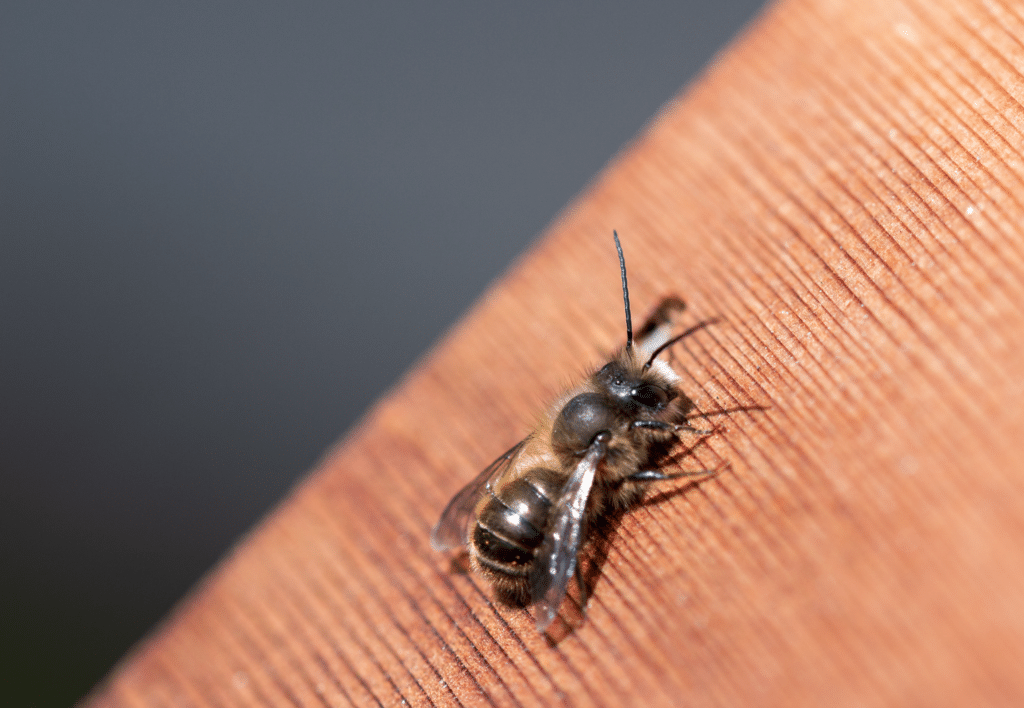
In the spring of 2022, Best Bees began selectively installing mason bee houses containing mason bee cocoons onto sites with pre-established honeybee hives in four different regions: Washington, D.C., Boston, Seattle, and San Francisco. It was the start of the first phase of the Native Pollinator Initiative (NPI), launched by our staff scientist Emily O’Neil. The NPI is an exciting expansion of the Best Bee mission to actively support and improve pollinator health, with a targeted focus on our native pollinators.
This first phase is an observational study for us to determine if it was appropriate to install mason bee houses and mason bees alongside honey bee hives, and, if so, what the best location would be for a mason bee house in relation to a honeybee hive.
We were in consultation with a diverse array of experts to design and launch this study at scale. Thus far, we have installed a total of 260 mason bees, specifically blue orchard bees, in 11 mason bee houses across the four regions.
The study revealed that there were no ‘bad’ places to put the mason bee houses in relation to the honey bee hives — we found that we could even place a mason bee house right on top of a beehive with no adverse effects to either one. The two pollinators didn’t compete for resources because of the difference in their foraging regions; honey bees venture out beyond the area surrounding their hive, whereas mason bees stick much closer to home when foraging.
Best Bees clients now have the option to purchase a bee hotel for their properties and adopt mason bees to populate it. Best Bees beekeepers, in addition to caring for and collecting data from the honey bee hives, will monitor the hotel and collect data to track its activity and occupancy. Learn more about this service offering here.
FAQ’s
Q: Are Mason Bees native pollinators?
A: Mason Bees are native to the United States and are therefore considered native pollinators.
Q: What are Mason Bees good for?
A: Mason Bees are known as fantastic pollinators, because their behavior within the flower covers them in pollen.
Q: What is the difference between a Mason Bee and a honey bee?
A: Mason Bees are solitary bees, while HoneyBees rely on a colony to survive. Mason Bees do not produce honey, and their life span is typically 6-8 weeks.
Q: Are Mason Bees dying?
A: In a recent study created by Scientific Reports, they found that six species of native Mason Bees steadily decreased in population over a span of 13 years.
Q: Do Mason Bees sting you?
A: Only female Mason Bees will sting, and they will only do so if they feel threatened. However, their stingers do not contain a venom like the Honeybee, so their stings are less painful.
Q: Do Mason Bees produce honey or beeswax?
A: Mason Bees do not produce honey or beeswax.
Q: Why are Mason Bees important?
A: Mason Bees are excellent pollinators and can pollinate 120 times more effectively than the Honeybee. 80% of the world’s plant crops require pollination in order to survive.


